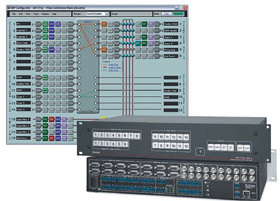Processing Contines To Move Throughout The Audio Chain
Sound level inconsistency is one of the most irritating facets of high-tech living. For many years now, systems contractors have had sophisticated DSP tools at their disposal to smooth out these rough audio edges. Not every application, though, needs the full feature set offered by dedicated audio DSP systems.
Which partly explains why Extron has just unveiled the MPX Plus 866 A ProDSP—the industry’s first AV matrix switcher with professional DSP onboard. The first fruit of a four-year in-house R&D program, the 866 is different from a ‘do anything’ DSP box, according to Extron’s vice president of marketing, Lee Dodson. “Typically a high-end box is a blank chalkboard, and you have to spend a lot of time setting it up and giving it its personality for each system you install. Ours is a matrix switcher that works out of the box, and if you want to adjust gain structure, delay, ducking, and these kinds of things, they are there for you.”
tExtron has just unveiled the MPX Plus 866 A
ProDSP, the industry’s first AV matrix switcher with
professional DSP onboard. this process began a little over a decade ago, when manufacturers of digital mixing consoles saw the opportunity to build more flexibility into their boards than had been possible using analog technology.
“As we developed each generation of digital mixers, we found our customers were asking for more of the DSP features traditionally handled by external processing to be integrated into the mixer itself,” reflected Marc Lopez, marketing manager, Yamaha Commercial Audio Systems. “This was especially true in applications where physical space or system cost were important issues.”
In 2007, Yamaha unveiled the NXAMP, a power amplifier that utilized DSP power from its (then) newly acquired partner, the French loudspeaker company Nexo. Most industry watchers believe we will see many more amps with processing built into them, and for good reason.
“When you put signal processing in the amp, you are at the last gain stage in the system,” said Miguel Hadelich, technical sales manager, touring, at TC Group Americas, which has the Lab.gruppen PLM series of Lake Processor-equipped amplifiers in its catalog. “Because you are closer to the loudspeaker, you can monitor its status, its temperature and its impedance, and tailor the processing accordingly.”
The need for synergy between amplifier and loudspeaker is, of course, one reason why some contractors prefer to specify powered speakers. For these applications, Lab.gruppen has just announced the LM26, a standalone Lake unit that features the same processing technology as the PLM amps.
At the same time, DSP has been a part of some loudspeakers for a number of years, and these designs are also becoming more sophisticated. “Our Messenger steerable line array is just about to enter its second generation,” said Anders Strom, managing director, Penton USA. “I thought the old one was good, but this has another 10dB and goes down to 40Hz. Beneath that, we have also just announced a steerable bass array which is a completely unique product in the contractor market.”
The seemingly endless search for greater control over audio parameters means there is no let-up in the R&D cycle. For its part, Peavey has seen fit to establish a Digital Research unit in Oxford, England, to cater to both current and future development needs. “The group has a mix of skills, some hardware, some software,” explained Dave Bearman, sales and marketing manager, Peavey Europe. “They cover the ongoing upgrading and providing new features for Nion, and beyond that, new product development—be it application engineering of existing technology, or raw R&D.”
So will we see further migration of DSP away from its traditional ‘black box’ location? The answer is probably yes—and no. As TC’s Hadelich put it: “DSP-equipped amps are more involved with loudspeaker processing, while standalone processors handle room EQ and zoning. There is actually an argument for having both. I don’t think either one is going to disappear.”
